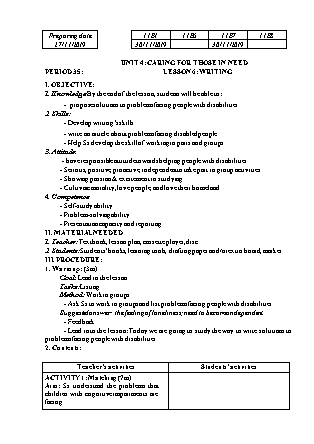Giáo án Tiếng Anh Lớp 11 (Thí điểm) - Unit 4: Caring for those in need - Lesson 6: Writing - Năm học 2019-2020

I. OBJECTIVE:
1. Knowledge: By the end of the lesson, students will be able to:
- propose solutions to problems facing people with disabilities.
2. Skills:
- Develop writing’s skills
- write an article about problems facing disabled people
- Help Ss develop the skill of working in pairs and groups
3. Attitude:
- have responsible attitude towards helping people with disabilities.
- Serious, positive, proactive, independent to take part in group activities.
- Showing passion & excitement in studying
- Cultivate morality, love people, and love their homeland
4. Competence:
- Self-study ability
- Problem-solving ability
- Presentation capacity and reporting
II. MATERIAL NEEDED
1. Teacher: Textbook, lesson plan, cassette player, disc.
2. Students: Students’ books, learning tools, drafting paper and/or extra board, marker
Preparing date 11B1 11B6 11B7 11B8 27/11/2019 30/11/2019 30/11/2019 UNIT 4: CARING FOR THOSE IN NEED PERIOD 35: LESSON 6: WRITING I. OBJECTIVE: 1. Knowledge: By the end of the lesson, students will be able to: - propose solutions to problems facing people with disabilities. 2. Skills: - Develop writing’s skills - write an article about problems facing disabled people - Help Ss develop the skill of working in pairs and groups 3. Attitude: - have responsible attitude towards helping people with disabilities. - Serious, positive, proactive, independent to take part in group activities. - Showing passion & excitement in studying - Cultivate morality, love people, and love their homeland 4. Competence: - Self-study ability - Problem-solving ability - Presentation capacity and reporting II. MATERIAL NEEDED 1. Teacher: Textbook, lesson plan, cassette player, disc. 2. Students: Students’ books, learning tools, drafting paper and/or extra board, marker III. PROCEDURE: 1. Warmup: (3m) Goal: Lead in the lesson Tasks: Listing Method: Work in groups - Ask Ss to work in groups and list problems facing people with disabilities Suggested answer: the feeling of loneliness; need to become independent. - Feedback - Lead into the lesson: Today we are going to study the way to write solutions to problems facing people with disabilities 2. Contents: Teacher’s activities Students’ activities ACTIVITY 1: Matching (7m) Aim: Ss understand the problems that children with cognitive impairments are facing. Method: Work in pairs - Gives the instruction and make sure that Ss understand it Read the sample writing about the problems that children with cognitive impairments are facing. Choose the appropriate phrases (a-c) to fill in the blanks. - Call some Ss to copy the answers on the board and check with the whole class. - Listen to the teacher and take notes if necessary. Do as appointed. - Compare their answers with a partner first - Read out loud their answers Keys expected 1.c; 2.b; 3.a ACTIVITY 2: (10m) Complete the outline on the sheet of paper. Aims: Ss get structure of the letter Methods: Work in pairs - Asks Ss to work in groups of 4, and give each group a large size sheet of paper - Have Ss read the text in their book and study the outline. Asks Ss to discuss in groups and complete the outline on the sheet of paper. - Encourages Ss to move around to look at the outlines of other groups. - Asks leaders of some groups to present their outlines to the rest of the class. - Work in groups of 4, and give each group a large size sheet of paper Discuss in groups and complete the outline on the sheet of paper. Leaders of some groups to present their outlines to the rest of the class. Keys expected: Introduction Children with cognitive impairments often face discrimination in life Main body Solution 1 People should learn more about children with cognitive impairments Solution 2 There should be more contacts between people with cognitive impairments and non-disabled people. Conclusion Better understanding and better cooperation between the two groups of people will change attitudes and reduce discrimination. ACTIVITY 3:(14m) Aims: Ss get some information to writing Methods: Work in groups - Have Ss work in groups of three or four to choose one problem and discuss what solutions they will recommend. - Encourages Ss to make complete sentences, using the suggestions in the table. Asks Ss to read their group’s sentences. - Provides help by correcting mistakes in grammar or word choice. - Asks Ss to work independently and write their articles. - Work in groups of three or four to choose one problem and discuss what solutions they will recommend. Work independently and write their articles. ACTIVITY 4: (7 m) Aims: correction Methods: Work in - When Ss have finished, asks Ss to hang on the sub= board on the board and check the mistakes with the whole class - Tell the class to read together and give corrections if necessary. Have the rest of class give comments, and correct errors. Give remarks & correction - Peer correction Listen to comments & correction 3. Consolidation and homework a. Consolidation: (2m) - Teacher summaries main points of the lesson - Students listen and add some more points b. Homework: (2m) - Do the task again - Prepare the next lesson at home.
Tài liệu đính kèm:
 giao_an_tieng_anh_lop_11_thi_diem_unit_4_caring_for_those_in.docx
giao_an_tieng_anh_lop_11_thi_diem_unit_4_caring_for_those_in.docx



